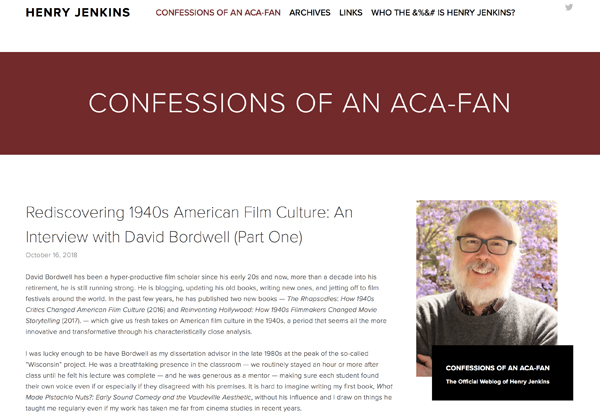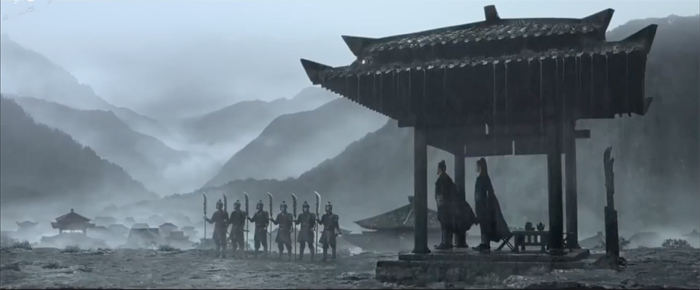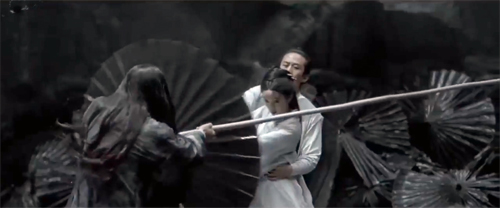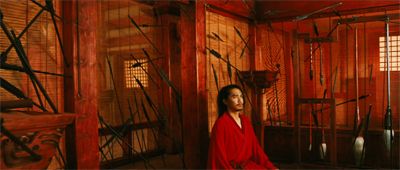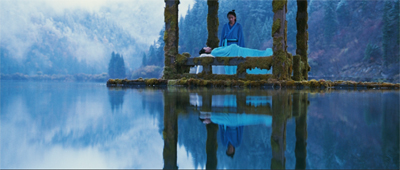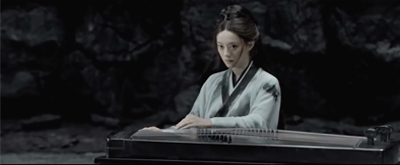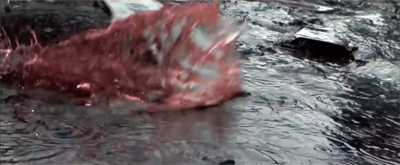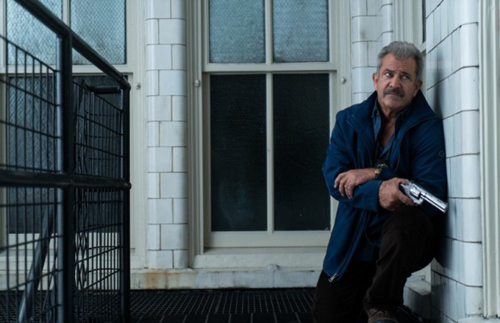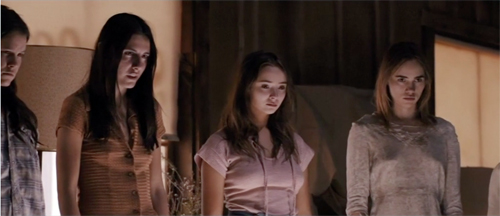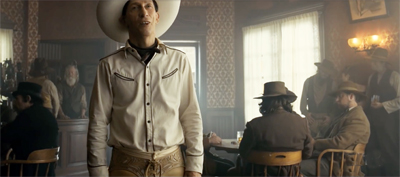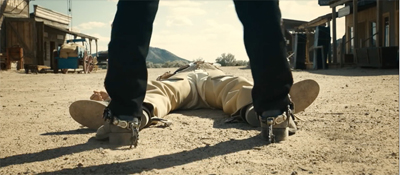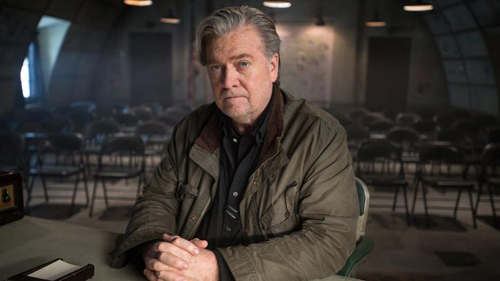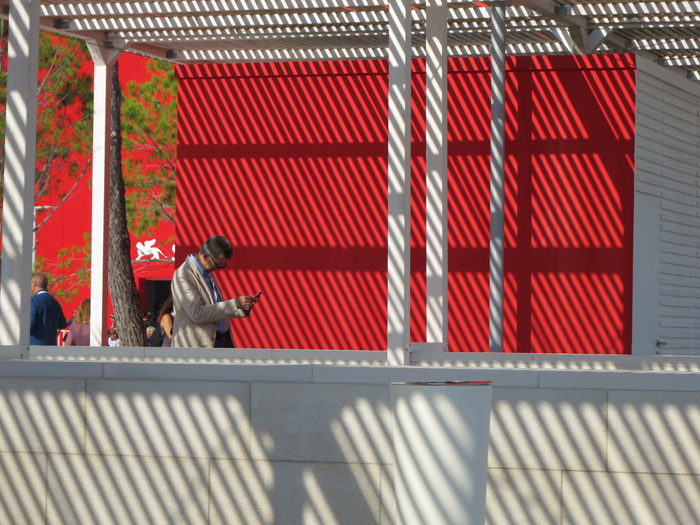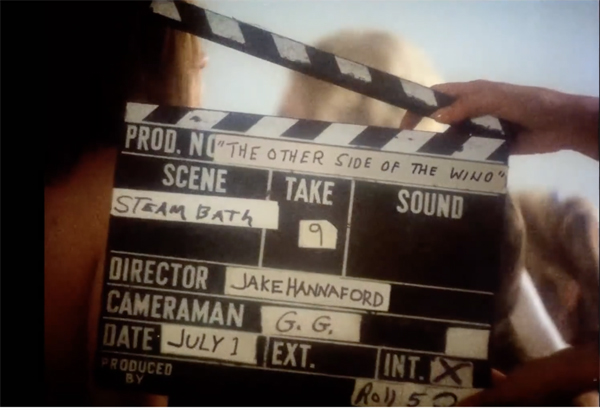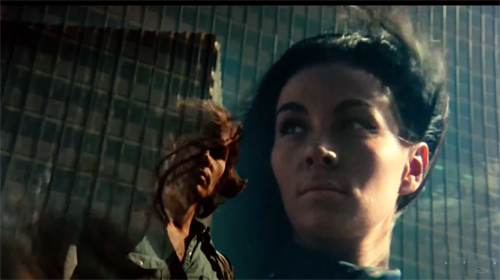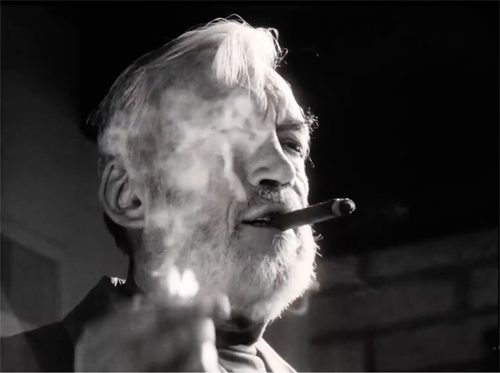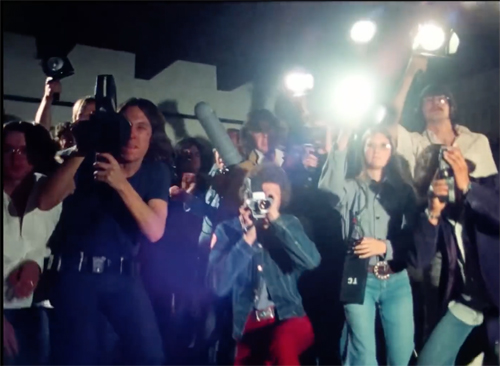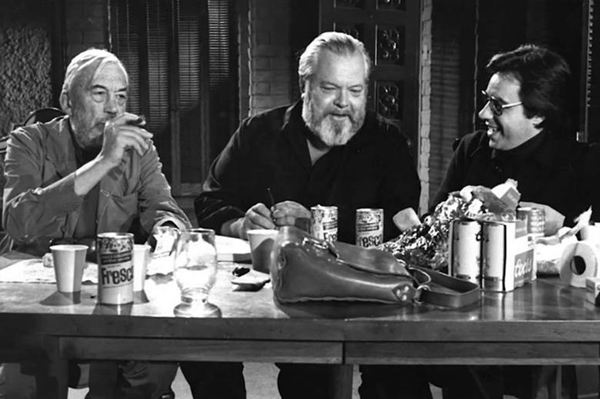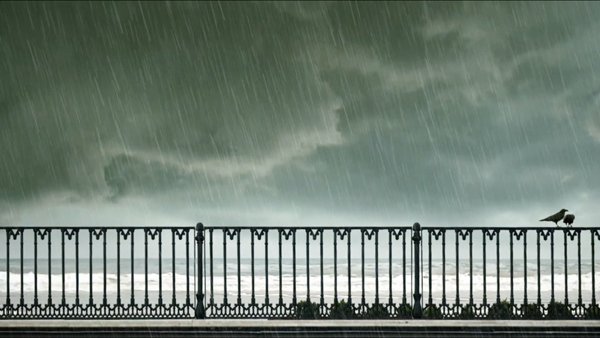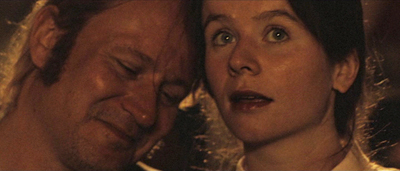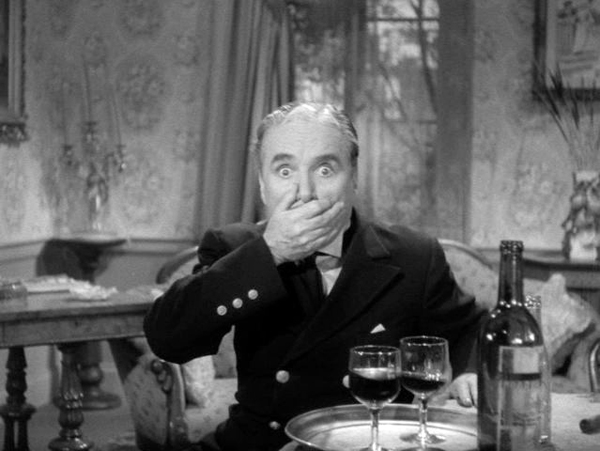Archive for the '1940s Hollywood' Category
Two aca-fans being aca, and a little fannish
You probably know Henry Jenkins’ vast website “Confessions of an Aca-Fan.” It hosts blog entries, essays, interviews, and a podcast. As both a media scholar (the aca part) and a connoisseur (the fan), Henry has wide-ranging interests. He analyzes/enjoys/celebrates/criticizes film, TV, comics, music, and videogames (he testified about them to Congress). He’s also a big advocate for the role of media in education and political change.
Henry was a student of ours here at Madison, and I directed his dissertation. That became the book What Made Pistachio Nuts? Early Sound Comedy and the Vaudeville Aesthetic. Currently celebrating its twenty-fifth anniversary, it’s still very much worth reading as an original and entertaining cultural study of movie comedy. While doing his dissertation, Henry was also writing his trailblazing study of fan culture, Textual Poachers: Television Fans and Participatory Culture. (It now has an updated, twentieth-anniversary edition.)
Soon enough he followed that with another influential book, Convergence Culture: Where Old and New Media Collide. The idea of “transmedia storytelling” that Henry set forth here became a byword for the media industry as well as for scholars; his prophecy that we’d see a lot more of it has come true with a vengeance. We had a nifty dialogue about the idea online some years back (here and here).
And these are just three of his seventeen books! Henry is an epic multitasker, so he has found the energy to be an inspiring teacher as well. All of us at Wisconsin are thoroughly proud of him.
Naturally, when Henry asked me to participate in an email interview around my two 1940s books, The Rhapsodes and Reinventing Hollywood, I felt honored. Now he has run our conversation in four installments on his site, starting here.
I hope the answers I provide will shed light on my research projects. (As for the fan part: Yes, The Greatest Showman and Game Night are mentioned.) At the least I think people will learn a lot from Henry’s questions. Thanks to him for reigniting the spark of conversations we’ve had over the years.
Venice 2018: Assorted malefactors
Ying (Shadow).
DB here:
You don’t have to be an addict of crime fiction to notice that bad behavior–from lying and cheating to assault and murder–is a prime motivation in all genres of storytelling. A gripping plot often depends not on innocent mistakes but something worse: an assassination plot (Macbeth), a savage robbery (Crime and Punishment), wicked mind games (Les Liaisons dangereuses). Some of my favorite films from the latest Venice Film Festival feature scurrilous intrigue and a whole lot worse. Hell, in one movie the subject was happy to be compared to Satan, and that was a documentary.
Shadow warrior
After the extravagantly peculiar Great Wall, Zhang Yimou has come back with a more sober, somewhat arty wuxia drama. Leaning a bit on the premise of Kurosawa’s Kagemusha, Ying (Shadow) presents a king trying to reclaim territory with the aid of a crafty general. But he’s relying on a ringer; the real general languishes in a secret chamber recovering from a severe wound. Court intrigue–the general’s wife falls in love with her husband’s double, the king’s sister resents his manipulation of her–builds toward a massive military attack on the Jing stronghold. The sister, in rebuff to the enemy’s insult to her, enlists in the ranks as well.
It’s quite a show. For one thing, Zhang has reengineered the color-design principles of Hero. There each flashback episode was keyed to a different palette.
In Ying, the settings exist almost entirely in deep blacks and soft grays. For most of the film, only flesh and blood are given in their natural colors, and even then they are pastels.
For another thing, in contrast to the overcast skies of Hero and in perhaps another Kurosawa nod, here it’s almost always raining. This constant downpour extends the gray-black color palette of the palace to the massive landscapes.
Above all, the training of the young imposter in a technique of fighting with a metallic umbrella leads to some memorable combat sequences. Little do we realize in the initial practice sessions that the umbrella technique will expand on a grand scale. Pei’s troops invade a town using umbrellas as bobsleds, and they attack the enemy with umbrellas as scythes and buzzsaws. Despite the fact that digital rain doesn’t bounce off shoulders or trickle down the tracery of armor, the water-drenched attack at the climax of Ying yields the tingling sense of tactile spectacle that we’ve come to expect from the maker of Red Sorghum.
Cops and/as crooks
Dragged Across Concrete (production still).
In another but not wholly different genre, we have S. Craig Zahler’s Dragged Across Concrete. I was unfamiliar with his two earlier features, Bone Tomahawk and Brawl in Cell Block 99, though alert viewer Dave Kehr urged me to see the latter last year. (I tried, on streaming, but I gave up because the image was too small; Zahler’s eye is calibrated for the big screen.) Now, seeing this latest enterprise smashed across the Lido’s Darsena screen, I’m here to declare myself a fan.
It’s got a neat structure. There are two protagonists. We’re first introduced to Henry Johns, a discharged prisoner. He’s ready to reenter a life of crime to keep his disabled brother safe and rehabilitate his mom, who’s tricking to support her drug habit. After twenty minutes, he drops out of the plot and we pick up Brett Ridgeman, a cop whose menacing interrogation techniques, captured on cellphone video, result in a suspension. Pressed by money problems and his wife’s MS, Ridgeman decides to get “proper compensation” by ripping off a gang planning a heist. Of course Henry and Ridgeman’s trajectories intersect, while drawing in others: Henry’s sideman Biscuit, Ridgeman’s partner Anthony, and a woman working at the company that’s the target of the robbery.
At two and a half hours, Dragged Across Concrete might seem to be an overinflated genre movie, but it owes its leisurely pace, I think, to the tradition of crime novelists like Lionel White, George V. Higgins, Elmore Leonard, and George P. Pelicanos. In their work crime, duplicity, betrayal, and revenge are at the center of a web of human relations. Unrestricted narration follows outlaws, cops, and bystanders whose fates will be intertwined with acts of violence. You need a certain amount of time to give solidity to the lives of these stakeholders in criminal action.
The sweep of such plotting allows us to appreciate irony, especially when characters misjudge each other’s motives. In Zahler’s film, the split structure of the narration–setting up Henry before we see Ridgeman–pays off in several ways. Having access to the frustrations that push Henry back into crime allows us to judge Ridgeman’s occasional bursts of bigotry as both understandable (given the treatment of his daughter in the neighborhood) but no less hateful. At the climax, there’s a crisis of trust that depends on mutual ignorance. Both Henry and Ridgeman err because each man doesn’t know something crucial about the other.
The film’s length is also warranted by Zahler’s classical approach to composition and cutting. He knows how to exploit anamorphic widescreen, to let the camera stay still and watch action unfolding.
The film’s title summons up Sam Fuller sensationalism (and Zahler’s overheated prose in his novels isn’t far removed from Sam’s). But the film reminded me of Jean-Pierre Melville and Kitano Takeshi, partly for the laconic dialogue but also for the deliberate pacing. (The average shot length is 6.5 seconds, about twice what we find in most Hollywood movies today.) Lacking Tarantino’s self-congratulatory flamboyance, Dragged Across Concrete exemplifies the power of a dry but not unemotional approach to genre conventions.
The Forties, yet again
Charlie Says.
Police thrillers like Dragged Across Concrete became salient creative options in the 1940s, as I tried to suggest in my book about that era in Hollywood. Other 1940s options surfaced in two other crime-based movies I saw at Venice.
The first, rarer choice, was the chaptered film, the movie broken into blocks that are marked as distinct. Meet Me in St. Louis does it by season, Holiday Inn by, well, holidays. We’ve become used to chaptering since Pulp Fiction revived the scheme.
In The Ballad of Buster Scruggs, Joel and Ethan Coen literalize the technique by beginning with an old-fashioned book consisting of six chapters. The tales all center on the American West, and each one is introduced by a captioned color plate and ends with a glimpse of the closing passages of text.
This direct address to the audience is carried on in the first episode, “You seen ’em, you play ’em.” Here the gunslinger Buster Scruggs tries to charm us while singing “Cool Water.” The conceit is that a fancy-pants singing cowboy is planted in the grubby, dangerous west of actual history.
At first Buster dispatches fast-draw artists, but when he meets his match he’s lofted to heaven in a goofy cadenza that recalls stretches of The Big Lebowski.
Thereafter we get tales of bank robbery and lynching (with a shaggy-dog punch line), a bleak carnival sideshow, gold prospecting, a wagon train, and a mysterious stagecoach ride. All are rendered with the patented Coen panache. Such a pleasure to see a movie that is designed, from first frame to last, to give you time to see everything. The Coens’ love of the grotesque, their eagerness to satirize movie conventions while still honoring them, their parodic side (e.g., the opening Leone riffs), and their gift for gorgeous landscapes and catchy tunes–all are here.
Still, the wagon-train episode, much in the spirit of True Grit, shows that not everything is fodder for mischief. The highly formal, archaic dialogues and grave sincerity of the performances in this section are for me deeply moving. The chaptering device itself carries a certain warmth; we might be kids discovering a great-grandparent’s childhood reading.
Mary Harron’s Charlie Says uses a more common 1940s template, that of an inquiry that triggers flashbacks to the past. It’s also, as Harron notes, a woman-in-prison movie. Karlene Faith is a feminist and social activist who counsels three women on Death Row. They participated in the murders instigated by cult leader Charles Manson. As she gets to know them and they probe her own life, we’re shown increasingly brutal episodes of their absorption into Manson’s brood.
The task of Harron and screenwriter Guinevere Turner was to make the women sympathetic and comprehensible. The script might have offered mini-biographies showing how each one’s unfulfilled life led her to fall prey to Manson’s manipulation. Instead, they make one woman, Leslie nicknamed Lulu by Charlie, our primary focus, and through her they lead us gradually into the monstrous crimes.
The early flashbacks, attached to Leslie as she enters the fold, emphasize Manson’s rather mild, almost offhand seduction style. At first he comes across as a gentle, guitar-strumming hippie wooing his followers with a lifestyle challenge: Give up consumerism, learn to live simply, share the love. Certain signals–the men always eat first, Charlie has claim on all the women–are outweighed by Manson’s glowering conviction and the group’s hopes that his songs will earn a record contract.
The flashbacks trace a shift from communitarian idealism to “subversive” rock music (the coded message in the Beatles’ “Helter Skelter”) to whacked-out politics. (Manson promises a race war in which blacks will need a leader like him.) Men as well as women fall under Charlie’s patriarchal management style. By the end, murdering the piggies through home invasion comes to be the ultimate test of Manson family values.
The flashbacks, shot in a nervous style in sun-soaked terrain, contrast with the locked-down camera and drab prison surroundings of the present. The unpretentious production values are matched by a sober style that favors the performances, particularly those of Hannah Murray, Merritt Wever, and in the flashiest role Matt Smith as Manson. In all, it’s a very worthy, unsensational effort to understand how naive idealism can be recruited by lunatic evil.
Better to reign in Hell
American Dharma (production still).
Speaking of lunatic evil, Donald Trump has had many abettors and acolytes, but few are as clever and intellectually pretentious as Steve Bannon. Errol Morris’s interview film, American Dharma, premiered at Venice and was put to the blade in the press conference.
Reporters’ objections seemed to me twofold.
You were too easy on him. You didn’t pose enough hard questions and you cut away when he fell silent. Morris replied that this was an investigation, not a debate. He wanted to probe Bannon’s worldview, not “pin him to the wall, like a butterfly expert handling a specimen.” And Morris does push Bannon on several points, notably the contrast between his apocalyptic intentions (Trump is the “blunt-force candidate, an armor-piercing shell”) and his earnest claim to be fighting for those people who want a stable, steady life. For my part, I thought that Morris scored points whenever the garrulous Bannon didn’t reply or changed the subject.
In addition, Morris peppers Bannon’s discourse with montages of cutaways to internet news and commentary. Like the newspaper headlines of The Thin Blue Line and Tabloid, this swarm of Facebookings, Twitteries, and soundbites acts as both challenge to what’s been said and a reminder of how the media snatch up phrases and images and spew them back at us, complicating and sometimes obscuring our understanding. At the very least, we’re reminded that there is pushback to virtually every lie put forth by the Trump regime: the Resistance will be videoized.
Nothing new here. What did we learn from this? Well, said Morris, we learn that “at the heart of his beliefs is a deep self-deception.” Morris challenged Bannon to explain how, if he believes that Trumpism is a populism on behalf of the forgotten middle class, all his policies are aimed to strengthen the wealthy and weaken the ordinary citizen. Bannon got quiet. And though Bannon claims to be a rationalist, he soon enough rails against rationalism.
All of which makes him a guy who has given a tongue bath to the Blarney Stone. A Hollywood investor with ties to the videogame industry, Bannon strikes me as less a thought leader than a canny VC opportunist, spraying out memes like a scriptwriter in a pitch session. He even assures us solemnly: “The medium is the message.” In his cascade of clichés I saw the desperate self-confidence of a hip boomer who wants to be the brightest boy in the meeting.
Along these lines I thought I learned something else important. Bannon the vaunted intellectual gets his inspiration from pop culture. Most of what I’ve read about his ideas emphasize their philosophical pedigree–his readings in Eastern and Western religion, his defense of Julius Evola–but it turns out that Bannon is a geek like the rest of us.
 When he draws life lessons from Paths of Glory and The Searchers, Morris punctures these absurd pretensions simply by literalizing them. This creep casts himself as Kirk Douglas or John Wayne? Like Falstaff in Chimes at Midnight, Bannon claims, he has prepared a carouser for rule before the pupil betrays the mentor. So Morris straight-facedly inserts Welles’ footage, and Bannon, no Fat Jack, is thereby shrunk. Likewise, Morris makes monumental fun of Bannon’s shallowness by building a duplicate of the Quonset hut of Twelve O’Clock High, Bannon’s favorite movie. In this set Bannon, not exactly Gregory Peck, is interrogated before Morris sets it ablaze.
When he draws life lessons from Paths of Glory and The Searchers, Morris punctures these absurd pretensions simply by literalizing them. This creep casts himself as Kirk Douglas or John Wayne? Like Falstaff in Chimes at Midnight, Bannon claims, he has prepared a carouser for rule before the pupil betrays the mentor. So Morris straight-facedly inserts Welles’ footage, and Bannon, no Fat Jack, is thereby shrunk. Likewise, Morris makes monumental fun of Bannon’s shallowness by building a duplicate of the Quonset hut of Twelve O’Clock High, Bannon’s favorite movie. In this set Bannon, not exactly Gregory Peck, is interrogated before Morris sets it ablaze.
I didn’t think that the journalists in the press conference gauged the ways in which Morris made Bannon seem naive. But I always forget that a hermeneutics of pop-culture justification, with The Simpsons and The Matrix fodder for philosophers trying to fill their courses, is taken for granted now. Bannon encountered Twelve O’Clock High when it was taught as a leadership model in, of all places, Harvard Business school. To my mind, Morris shows that the would-be highbrow’s search for allegories in mass culture is a caricature of serious thinking.
Another piece of news: Bannon admits to being a Miltonic rebel angel, one who would rather reign in Hell than serve in Heaven. Think about that. Morris got Bannon to embrace Satan. He asked, with justification: “How many interviewers have done that?” Errol Morris, boy detective, may have revealed the real puppeteer behind Trump’s coup d’état: the petty overachiever swollen with dreams of grandeur drawn from movies.
This is my last dispatch from a festival that became a high point of my cinephiliac life. Apart from seeing fine films in splendid circumstances, talks with Dave Kehr, Chris Vognar, Michael Philips, Glenn Kenny (some choice reviews here), Stephanie Zacharek, Mick LaSalle, Kim Hendrickson, Peter and Françoise Cowie, Alberto Barbera, Michel Ciment, Olaf Möller, and other friends have set me thinking ever since.
As ever, thanks to Paolo Baratta, Alberto Barbera, Peter Cowie, Michela Lazzarin, and all their colleagues for their warm welcome to this year’s Biennale.
For more Venice snapshots, see our Instagram page.
October 31, 2018: Netflix has announced that The Ballad of Buster Scruggs will be narrowly platformed starting November 8 and will premiere on its streaming service on November 16; also on the 16th it will show in selected theaters in the US and Europe, as well as Toronto.
Venice 2018: Welles and THE OTHER SIDE OF THE WIND
DB here:
The Venice Biennale film festival unveiled to a panting cinephile public the long-rumored Welles film The Other Side of the Wind, now reconstructed thirty-three years after its director’s death. This is only one of many possible versions. Welles reportedly edited two scenes himself, including an erotic encounter in a rainstorm-shaken car, but the rest has been assembled from about a hundred hours of footage. (But see the PS in the codicil below.) Welles left many notes but no definitive script, so editor Bob Murawski, with guidance from many Welles experts, has carved out something that must stand as a best approximation what its initiator had in mind.
Approximation is also the word for my response. I need to see the film more than once in order to get to grips with it. Not that it’s a dense, complex work; I don’t think it is. It’s just that I need to shake off a sense of déja vu.
Or rather, déja lu. Having read about the film for years, I found almost nothing onscreen that I hadn’t been primed for by press coverage, by Joe McBride’s What Ever Happened to Orson Welles?, and by Josh Karp’s Orson Welles’s Last Movie. I found myself groping for a triple vision: How to imagine seeing the film fresh, without knowing its plot, characterization, and most pungent lines already? And then, how would it have looked and felt in the context of 1970s filmmaking? Finally, of course, how to consider it now, in the context of modern cinema?
Sorry, but I’m far from having an answer to any of these questions. Herewith, just some things that the film made me think about.
All together now
One persistent narrative premise, on stage and screen, might be called the climactic gathering. The plot is concentrated in a limited space and a short span of time–a day, or better, a night. The occasion is a meeting or party that brings together friends, acquaintances, associates, or kinfolk. As time passes, quarrels break out, old wounds rip open, and eventually family secrets and past transgressions are exposed. Examples of this dramaturgy are O’Neill’s Long Day’s Journey into Night, Albee’s Who’s Afraid of Virginia Woolf?, and films like Twelve Angry Men, A Wedding, Margin Call, and The Celebration.
The advantages of this format are many. The limits of time and place realistically assemble characters for intense confrontations, and those can be interwoven quickly to maintain audience interest. Actors like such a setup because the deterioration of civility that usually comes with the situation allows them to show a range of emotions that will culminate in bravura breakdowns. But the disadvantage is a certain obviousness: the secrets or suppressed feelings or traumatic memories will have to be stated rather nakedly. Subtlety may not be easy to achieve.
The Other Side of the Wind situates the climactic-gathering format in Movieland. After filming a stretch of director Jake Hannaford’s work in progress, called The Other Side of the Wind, cast and crew and hangers-on drive out to his house. The party aims to celebrate his seventieth birthday and, perhaps, enable him to drum up finishing money. A night of uninhibited drinking and verbal sniping is broken by screenings of parts of Hannaford’s film. At the climax, Hannaford drives away to a fatal car crash.
Welles, being Welles, puts new twists on the template. In Reinventing Hollywood, my book on 1940s cinema, I argued that he, like Hitchcock, was under unusual pressure to keep coming up with new ideas. Both filmmakers were so widely copied that they had to outrun their imitators. As Welles told Gary Graver, his loyal DP in his late years:
Somebody always has to be ahead of everybody else. I have to be steps ahead of everybody. I have to be more inventive and do things that nobody has done.
His urge to innovate helped fuel the fifteen years he devoted to shooting and cutting The Other Side of the Wind. This jaundiced satire of Hollywood displays some striking formal strategies–some original for the period, some familiar from his other work, but all an effort to galvanize audiences as he had throughout his career.
A man’s man
This Hollywood party is rendered in blunt satire and in-jokes. It’s haunted by Mr. Pister (Joseph McBride), a geeky film critic asking questions about phallic symbols and the camera’s quest for reality. A more acerbic critic, Juliet Riche (Susan Strasberg), is a stand-in for Pauline Kael, who wrote a notorious broadside against Welles. Peter Bogdanovich plays the implausibly named Brooks Otterlake, a younger, successful director who is both a disciple of Hannaford’s (he calls Jake “Skipper” and “Daddy”) and a rival to him. Familiar faces from the studio years–Paul Stewart, Dan Tobin, Mercedes McCambridge–as well as younger figures like Paul Mazursky and Henry Jaglom make appearances. This climactic gathering brings together New Hollywood and Old, even Elderly, Hollywood.
By casting John Huston as the lanky, roguish Hannaford, Welles adds an evocative layer to the citations. Welles had acted in several Huston films; now Huston is in front of the camera, his face resembling, in Dwight Macdonald’s phrase, a relief map of the Dakota badlands. He was nine years older than Welles, but he made his directorial debut with The Maltese Falcon in the same year as Citizen Kane. Significantly, his star rose after Welles’s fell. By the time Huston won acclaim with The Treasure of the Sierra Madre (1948) and The Asphalt Jungle (1950), Welles was unemployable as a Hollywood director and scrounging work in Europe.
Karp reports that Welles told Huston that his role was a critique of all egotistical directors—“It’s about us, John”—and Welles considered playing the part himself. But Welles wouldn’t have fit the more specific target the film seems to home in on, the swashbuckling filmmakers like Rex Ingram, Howard Hawks, and William Wellman. Huston embodied the hunting-shooting-fishing-punching persona to the full. In this context, Riche’s suggestion that Jake Hannaford harbors gay desires for his male stars takes on a special bite.
Was Welles taking jabs at Huston’s image? I have to wonder. While Welles was fleeing hotel bills and performing offhand magic on talk shows, Huston maintained an active studio career; he took leave from Other Side to make one of his biggest successes, The Man Who Would Be King (1975). At the least, Hannaford’s climactic gathering can be seen as another sort of convergence, bearing the traces of the contrasting 1970s fates of two prodigious directors who came up together.
Cameras and cutting
The notion of tracing a day and night in the lives of several movie people was sharpened by Welles’ decision to shoot The Other Side of the Wind in a reflexive cinéma-vérité style. Today we accept a grab-and-go documentary look as a legitimate approach to fictional presentation, but in Other Side the technique is given a realistic pretext. Anticipating the premise of The Office and other TV shows, Welles’ innovation was to provide specific sources for everything we see and hear: an array of cameras and tape recorders. Here even intimate exchanges are captured by at least one camera.
In a way, this idea reverts to Welles’ lifelong interest in the how of storytelling. His radio plays, under the rubric “First Person Singular,” often framed their stories within a narrator’s commentary. This Conradian inclination toward embedded tales, brilliantly managed in his Mercury radio adaptation of Dracula, emerged as well in Kane and The Magnificent Ambersons. Other Side’s mosaic of scenic bits harks back to the montage of sources (dance music, government announcement, network news bulletins, voice-over diary entries) that fill the War of the Worlds broadcast (1938).
Like Kane, Other Side opens with the main action already completed. An image of a crumpled car is accompanied by Bogdanovich/Otterlake’s voice explaining that Hannaford died in a crash after his party. (Apparently, Welles would himself have supplied this narration.) That explanation frames the footage that has been assembled documenting Jake’s last day on earth. Embedded in all that material, mostly black and white and in 4:3 format, are scenes from Hannaford’s last movie, in ripe color and widescreen and full of arty compositions and one frequently naked lady. Although they’re motivated as being projected to various audiences in the film, at the end some of the imagery seems to float free, being intercut with the documentary material.
The result is an extended experiment, more radical than even Rear Window, in the Kuleshov effect. Cuts between cameras and partyers, or people in conversation, are linked solely by our understanding of the context; there are few establishing shots. The cuts link shots that were made months or years apart, in any of the many houses Welles commandeered as his sets.
Admittedly, he had been up to such tricks before. The instructive documentary They’ll Love Me When I’m Dead (also screened at Venice) shows an example from Othello of shot/reverse shot cutting based on vast gaps in production time. But Other Side‘s shifting cast and locales have created Welles’s most disjunctive, fragmentary film. I counted about 2300 shots in 117 minutes, an average of three seconds per shot. He applied the same approach in F for Fake (1973), but that feels less scrappy because Welles’s buoyant voice-over glues everything together.
On this blog we try to practice a criticism of enthusiasm, writing mostly about films we admire and avoiding panning the films we don’t. Still, as a lifelong Welles fan, I can’t duck an initial appraisal.
I confess being disappointed by the film. I’m not ready to call it The Other Side of the Windbag, but I’m not sure it escapes the on-the-nose quality we often find in the climactic-gathering format. Here people must get both nasty and horribly transparent about baring their feelings. Moreover, the film-within-the-film, shot in glowing color and abstract cityscapes, is supposed to be a parody of Antonioni (Zabriskie Point in particular), but (a) most of it is more like a slick-magazine version of a trance film from the 40s like Meshes of the Afternoon; and (b) it’s inconceivable that even in the Love Era Hannaford’s project could receive commercial funding or release. It seems to me a bad idea of what a bad movie looks like.
Still, I’m trying to keep an open mind. Watching it more analytically and reading what critics write about it may open it up for me in ways I can’t now predict. For the moment, it’s satisfying enough to thank Netflix for enabling us to see in however hypothetical a form, what forty years’ fuss has been about.
As ever, thanks to Paolo Baratta, Alberto Barbera, Peter Cowie, Michela Lazzarin, and all their colleagues for their warm welcome of us to this year’s Biennale. I’ve especially enjoyed discussing The Other Side of the Wind with Peter, whose The Cinema of Orson Welles shaped my view of the director’s career way back in 1965.
My quotation from Gary Graver comes from Joe McBride’s What Ever Happened to Orson Welles?, p. 225.
For more on the Kuleshov effect, see “What happens between shots happens between your ears” and “They’re looking for us.”
Feel free to visit our Instagram page for an ever-expanding set of snapshots of the Venice festival.
P.S. 5 September 2018: Standard accounts suggest that Welles completed editing only two sequences. Alert reader Evan Davis points out that editor Bob Murawski says that Welles edited about 30% of the finished film. Thanks to Evan for this.
I apologize for the typos and whiffs in this entry; we’ve had unreliable access to the Net lately, and not all revisions took.
P.S. 8 September 2018: Ardent Wellesian Jim Naremore has created his own website, and it’s must reading for every cinephile. Right off the bat he gives us a thoughtful piece, “Orson Welles, Citizen of the World,” available in English only online. Watch for Jim’s essay on The Other Side of the Wind, slated to be published in Cineaste.
John Huston, Orson Welles, and Peter Bogdanovich on the set of The Other Side of the Wind.
Is there a blog in this class? 2018
24 Frames (2017)
Kristin here:
David and I started this blog way back in 2006 largely as a way to offer teachers who use Film Art: An Introduction supplementary material that might tie in with the book. It immediately became something more informal, as we wrote about topics that interested us and events in our lives, like campus visits by filmmakers and festivals we attended. Few of the entries actually relate explicitly to the content of Film Art, and yet many of them might be relevant.
Every year shortly before the autumn semester begins, we offer this list of suggestions of posts that might be useful in classes, either as assignments or recommendations. Those who aren’t teaching or being taught might find the following round-up a handy way of catching up with entries they might have missed. After all, we are pushing 900 posts, and despite our excellent search engine and many categories of tags, a little guidance through this flood of texts and images might be useful to some.
This list starts after last August’s post. For past lists, see 2007, 2008, 2009, 2010, 2011, 2012, 2013, 2014, 2015, 2016, and 2017.
This year for the first time I’ll be including the video pieces that our collaborator Jeff Smith and we have since November, 2016, been posting monthly on the Criterion Channel of the streaming service FilmStruck. In them we briefly discuss (most run around 10 to 14 minutes) topics relating to movies streaming on FilmStruck. For teachers whose school subscribes to FilmStruck there is the possibility of showing them in classes. The series of videos is also called “Observations on Film Art,” because it was in a way conceived as an extension of this blog, though it’s more closely keyed to topics discussed in Film Art. As of now there are 21 videos available, with more in the can. I won’t put in a link for each individual entry, but you can find a complete index of our videos here. Since I didn’t include our early entries in my 2017 round-up, I’ll do so here.
As always, I’ll go chapter by chapter, with a few items at the end that don’t fit in but might be useful.
[July 21, 2019: In late November, 2018, the Filmstruck streaming service ceased operation. On April 8, 2019, it was replaced by The Criterion Channel, the streaming service of The Criterion Collection. All the Filmstruck videos listed below appear, with the same titles and numbers, in the “Observations on Film Art” series on the new service. Teachers are welcome to stream these for their classes with a subscription.]
Chapter 3 Narrative Form
David writes on the persistence of classical Hollywood storytelling in contemporary films: “Everything new is old again: Stories from 2017.”
In FilmStruck #5, I look at the effects of using a child as one of the main point-of-view figures in Victor Erice’s masterpiece: “The Spirit of the Beehive–A Child’s Point of View”
In FilmStruck #13, I deal with “Flashbacks in The Phantom Carriage.”
FilmStruck #14 features David discussing classical narrative structure in “Girl Shy—Harold Lloyd Meets Classical Hollywood.” His blog entry, “The Boy’s life: Harold Lloyd’s GIRL SHY on the Criterion Channel” elaborates on Lloyd’s move from simple slapstick into classical filmmaking in his early features. (It could also be used in relation to acting in Chapter 4.)
In FilmStruck #17, David examines “Narrative Symmetry in Chungking Express.”
Chapter 4 The Shot: Mise-en-Scene
In choosing films for our FilmStruck videos, we try occasionally to highlight little-known titles that deserve a lot more attention. In FilmStruck #16 I looks at the unusual lighting in Raymond Bernard’s early 1930s classic: “The Darkness of War in Wooden Crosses.”
FilmStruck #3: Abbas Kiarostami is noted for his expressive use of landscapes. I examine that aspect of his style in Where Is My Friend’s Home? and The Taste of Cherry: “Abbas Kiarostami–The Character of Landscape, the Landscape of Character.”
Teachers often request more on acting. Performances are difficult to analyze, but being able to use multiple clips helps lot. David has taken advantage of that three times so far.
In FilmStruck #4, “The Restrain of L’avventura,” he looks at how staging helps create the enigmatic quality of Antonionni’s narrative.
In FilmStruck #7, I deal with Renoir’s complex orchestration of action in depth: “Staging in The Rules of the Game.”
FilmStruck #10, features David on details of acting: “Performance in Brute Force.”
In Filmstruck #18, David analyses performance style: “Staging and Performance in Ivan the Terrible Part II.” He expands on it in “Eisenstein makes a scene: IVAN THE TERRIBLE Part 2 on the Criterion Channel.”
FilmStruck #19, by me, examines the narrative functions of “Color Motifs in Black Narcissus.”
Chapter 5 The Shot: Cinematography
A basic function of cinematography is framing–choosing a camera setup, deciding what to include or exclude from the shot. David discusses Lubitsch’s cunning play with framing in Rosita and Lady Windermere’s Fan in “Lubitsch redoes Lubitsch.”
In FilmStruck #6, Jeff shows how cinematography creates parallelism: “Camera Movement in Three Colors: Red.”
In FilmStruck 21 Jeff looks at a very different use of the camera: “The Restless Cinematography of Breaking the Waves.”
Chapter 6 The Relation of Shot to Shot: Editing
David on multiple-camera shooting and its effects on editing in an early Frank Capra sound film: “The quietest talkie: THE DONOVAN AFFAIR (1929).”
In Filmstruck #2, David discusses Kurosawa’s fast cutting in “Quicker Than the Eye—Editing in Sanjuro Sugata.”
In FilmStruck #20 Jeff lays out “Continuity Editing in The Devil and Daniel Webster.” He follows up on it with a blog entry: “FilmStruck goes to THE DEVIL”,
Chapter 7 Sound in the Cinema
In 2017, we were lucky enough to see the premiere of the restored print of Ernst Lubitsch’s Rosita (1923) at the Venice International Film Festival in 2017. My entry “Lubitsch and Pickford, finally together again,” gives some sense of the complexities of reconstructing the original musical score for the film.
In FilmStruck #1, Jeff Smith discusses “Musical Motifs in Foreign Correspondent.”
Filmstruck #8 features Jeff explaining Chabrol’s use of “Offscreen Sound in La cérémonie.”
In FilmStruck #11, I discuss Fritz Lang’s extraordinary facility with the new sound technology in his first talkie: “Mastering a New Medium—Sound in M.”
Chapter 8 Summary: Style and Film Form
David analyzes narrative patterning and lighting Casablanca in “You must remember this, even though I sort of didn’t.”
In FilmStruck #10, Jeff examines how Fassbender’s style helps accentuate social divisions: “The Stripped-Down Style of Ali Fear Eats the Soul.”
Chapter 9 Film Genres
David tackles a subset of the crime genre in “One last big job: How heist movies tell their stories.”
He also discusses a subset of the thriller genre in “The eyewitness plot and the drama of doubt.”
FilmStruck #9 has David exploring Chaplin’s departures from the conventions of his familiar comedies of the past to get serious in Monsieur Verdoux: “Chaplin’s Comedy of Murders.” He followed up with a blog entry, “MONSIEUR VERDOUX: Lethal Lothario.”
In Filmstruck entry #15, “Genre Play in The Player,” Jeff discusses the conventions of two genres, the crime thriller and movies about Hollywood filmmaking, in Robert Altman’s film. He elaborates on his analysis in his blog entry, “Who got played?”
Chapter 10 Documentary, Experimental, and Animated Films
I analyse Bill Morrison’s documentary on the history of Dawson City, where a cache of lost silent films was discovered, in “Bill Morrison’s lyrical tale of loss, destruction and (sometimes) recovery.”
David takes a close look at Abbas Kiarostami’s experimental final film in “Barely moving pictures: Kiarostami’s 24 FRAMES.”
Chapter 11 Film Criticism: Sample Analyses
We blogged from the Venice International Film Festival last year, offering analyses of some of the films we saw. These are much shorter than the ones in Chapter 11, but they show how even a brief report (of the type students might be assigned to write) can go beyond description and quick evaluation.
The first entry deals with the world premieres of The Shape of Water and Three Billboards outside Ebbing, Missouri and is based on single viewings. The second was based on two viewings of Argentine director Lucretia Martel’s marvelous and complex Zama. The third covers films by three major Asian directors: Kore-eda Hirokazu, John Woo, and Takeshi Kitano.
Chapter 12 Historical Changes in Film Art: Conventions and Choices, Traditions and Trends
My usual list of the ten best films of 90 years ago deals with great classics from 1927, some famous, some not so much so.
David discusses stylistic conventions and inventions in some rare 1910s American films in “Something familiar, something peculiar, something for everyone: The 1910s tonight.”
I give a rundown on the restoration of a silent Hollywood classic long available only in a truncated version: The Lost World (1925).
In teaching modern Hollywood and especially superhero blockbusters like Thor Ragnarok, my “Taika Waititi: The very model of a modern movie-maker” might prove useful.
Etc.
If you’re planning to show a film by Damien Chazelle in your class, for whatever chapter, David provides a run-down of his career and comments on his feature films in “New colors to sing: Damien Chazelle on films and filmmaking.” This complements entries from last year on La La Land: “How LA LA LAND is made” and “Singin’ in the sun,” a guest post featuring discussion by Kelley Conway, Eric Dienstfrey, and Amanda McQueen.
Our blog is not just of use for Film Art, of course. It contains a lot about film history that could be useful in teaching with our other textbook. In particular, this past year saw the publication of David’s Reinventing Hollywood: How 1940s Filmmakers Changed Hollywood Storytelling. His entry “REINVENTING HOLLYWOOD: Out of the past” discusses how it was written, and several entries, recent and older, bear on the book’s arguments. See the category “1940s Hollywood.”
Finally, we don’t deal with Virtual Reality artworks in Film Art, but if you include it in your class or are just interested in the subject, our entry “Venice 2017: Sensory Saturday; or what puts the Virtual in VR” might be of interest. It reports on four VR pieces shown at the Venice International Film Festival, the first major film festival to include VR and award prizes.
Monsieur Verdoux (1947)












